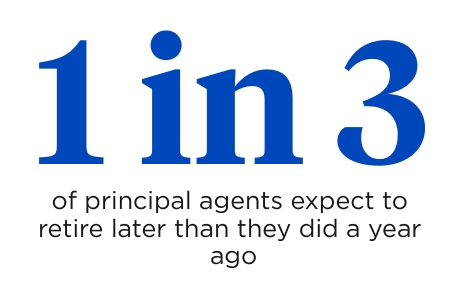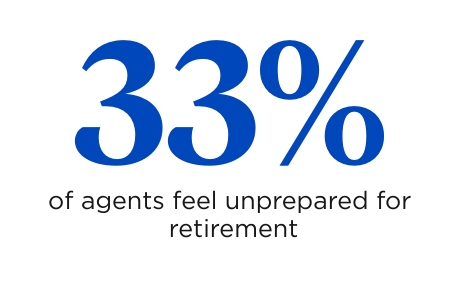Succession planning for insurance agencies
The viability of an insurance agency is often contingent upon having strong leadership. Senior leaders devote their time and effort to driving revenue today while building the value of their organization. They also help navigate top business challenges, which, according to recent Nationwide research includes inflation, reaching new customers and high interest rates. One challenge many insurance agencies overlook is perhaps one of the most important elements of fostering long-term success—business succession planning. Nationwide’s recent research found that roughly 1 in 3 of principal agents are now expecting to retire later than they did just one year ago, and 33 percent feel unprepared.1 Given these challenges and changing plans, it’s especially important to prioritize succession planning.
What is succession planning?
Succession planning is the identification and development of potential successors for key positions in an agency. It explains how and when leadership responsibilities will be transferred to a successor after a current owner or leader transitions out of their role. Succession planning aims to ensure that an agency will be able to carry out its mission and meet company goals in the future—even after current central members are no longer with the organization.
According to succession plan best practices, a succession plan should include:
- Chosen successors
- Succession training plans
- Roles and responsibilities of management during the transition
- Logistics related to share purchasing and selling
- Distribution of ownership decisions
- Financial, tax, and legal considerations
- Retirement arrangements
- Contingency plans
- Communication processes
- A general succession timetable
Above all, succession plans are designed to help account for all the “what if?” scenarios that can arise when ownership or leadership changes within an agency. In most cases, it’s best to involve the outside assistance of local legal counsel when developing such a plan.
Why is succession planning important?
Having a succession plan is important for a variety of reasons. To start, this plan can help insurance agencies prepare for the unknown. After all, an emergency event that leaves a senior leader unable to perform their duties could happen at any time. An effective succession plan can give the impacted agency the resources they need to respond amid such an event. Succession planning can also help ensure an agency is prepared for outcomes such as mergers and acquisitions, which have become more common in today’s insurance marketplace.
In addition to these events, it’s inevitable that senior leaders will eventually need to retire; a succession plan can help ensure the stability of the affected agency doesn’t suffer when this happens. Especially as it pertains to family-owned agencies, having this type of plan in place can also keep the business within the family. This is particularly important considering the majority of family-owned businesses hope to keep control within the family, but only around two-thirds have documented and communicated a plan.2 While many family-owned agencies are incentivized to plan ahead to keep the agency in the family, non-family-owned businesses lack this incentive—but still should understand the importance of this process.
Succession planning is also essential because decisions now may inform hiring strategies, as agencies that hire correctly now allow may be better equipped for a future transition. Studies have found that the average age of an insurance broker in the United States is almost 60 years old. To account for the aging workforce, agencies must work to bring in new talent. However, many new hires don’t last long in the insurance industry, creating challenges for finding the right employees to develop into potential leadership roles.
Lastly, succession planning can help protect the legacy of an agency and its leadership. An effective plan can help ensure that future generations are set up to operate the agency successfully and add value to the communities they serve.
Roles and responsibilities of successors
Establishing a successor means that the person to whom the business will be transferred is not only identified but also trained to run the agency. Many agencies identify these successors years in advance and then train them in their future leadership roles. Generally speaking, agencies usually choose family members, current employees, business partners, brokers, competitors, or third parties as successors; yet keep in mind that agencies may not always have full ownership over this decision. In any case, a strong successor should be able to:
- Manage employees and resources successfully
- Work well with others and demonstrate impeccable people skills
- Understand the value of hard work and be trustworthy and honest
- Possess the skills required to succeed in the role
- Know the ins and outs of the business and insurance industry
This list highlights a few common traits of potential successors but doesn’t necessarily account for intangibles. Insurance is a people business, and successors must have the right fit.
Succession planning strategy and steps
The truth is it’s never too early to start succession planning. While some experts suggest creating a plan five years before a senior leader’s retirement or exit date, succession planning steps can begin the moment an agency opens its doors. Creating this plan well in advance can help agencies uphold their business goals, maintain financial stability, and minimize confusion or potential disruptions during transition periods. What it takes for a successful plan may vary by agency, but here are some key succession planning steps:
- Assess the situation. To properly assess all the necessary aspects required for succession planning, an agency needs to have a firm grasp on the current state of its business and operations. This will help to not only get a fair price for the business if a buyout or sale occurs but will also assist in determining what steps the agency needs to take to be in a good position before a senior leader’s desired exit date.
- Assemble a team. A number of professionals and key partners can help ensure that an agency’s leadership makes the right decisions and develops sound succession planning strategies. Ideally, some of these individuals will have experience aiding other businesses in developing succession plans and can help an agency better understand the benefits of succession planning. Examples of candidates that could help bolster an advisory team include accountants, lawyers, business leadership, business valuators, and—if applicable—family.3 During this process, carriers such as Nationwide can also be beneficial partners by providing resources, experience, and expertise to help guide an agency.
- Develop a written succession plan. It’s important to document and formalize the succession plan once details are clarified. Typically, these plans can require 1-3 years of development prior to successor preparation and the change in leadership.4 It should be overarching and address all details and contingencies.
- Create an exit strategy. Choosing to move on from an agency is a difficult enough decision. That’s why understanding exit options and selecting the one that best fits the situation is a critical component of succession planning. Consulting with an advisory team during this point of planning can make this process easier.
- Prepare the successor. Ideally, the successor also has adequate time to learn what has made the agency successful and how to effectively continue operations into the future. Current leadership should prioritize passing on their experience and unique operational knowledge about running their agency. When confident that the right choice has been made for a successor and they have been properly trained, it’s time to make it official.
- Communicate the change. This process includes clearly informing the business and its employees of the decision of current leadership or ownership stepping down. Communicating the change as early as possible can help the agency prepare effectively. While outgoing leadership can focus on highlighting any changes, it’s also worthwhile to inform employees of what is not changing. Likewise, it’s important to effectively communicate the change to clients and policyholders to keep them informed and reassured of continued strength.5
- Begin the transition. Finally, it will be time to begin the transition. A plan should be in place by this time, and the agency should be ready to execute the succession process.
Changing agency leadership or ownership can be challenging. Fortunately, succession plans can help make this process easier. By taking proactive steps and developing effective succession plans, insurance agencies can easily navigate these periods of change and promote business vitality as they begin a new chapter. Find more insights on managing your agency, from technology to marketing, and more.
Citations/Disclaimers
-
1
June 2024 Nationwide Economic Impact findings
-
Survey Methodology:
Nationwide partnered with Edelman Data & Intelligence to conduct a 15-minute national online survey of 500 small business owners, defined as owners of companies with 1-50 employees and less than $10 million in annual revenue, 200 mid-market business owners, defined as owners of companies with either 51-500 employees or $10 million -$500 million in revenue and 400 independent insurance agents, defined as a mixture of principals, producers, and customer service representatives. The small and mid-market business owner survey was fielded from October 7-27, 2022, and the independent agent survey was fielded from October 24-November 4, 2022. As a member in good standing with The Insights Association as well as ESOMAR Edelman Data & Intelligence conducts all research in accordance with local, national and international laws as well as in line with all Market Research Standards and Guidelines.




